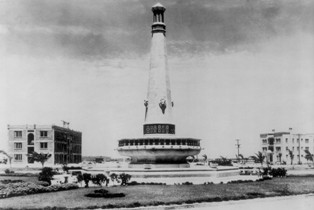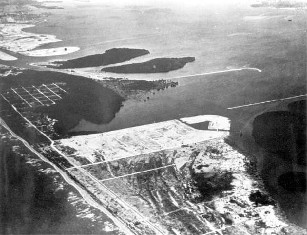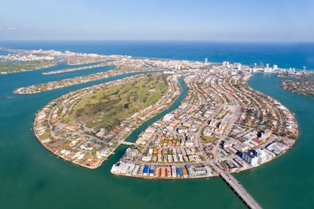
Standing tall and proud, the majestic fountain that Henri Levy planned and built in 1925 is still as it was, splashing gently on the plaza at Rue Vendome. The fountain and four apartment houses were the first structures built on Normandy Isle, the creation of which in and of itself required a great deal of patience.
After South Florida experienced the devastating hurricane of 1926, Henri Levy re-grouped and repaired damage to the community he had founded. And not satisfied to have accomplished so much, he then set about connecting it all to the mainland. The intrepid entrepreneur joined with governmental agencies and had the 79th Street Causeway built by 1929. Named for the street to which it connects on the mainland, the causeway leads to 71st Street on Normandy Isle, which in June 2009 was appropriately renamed Henri Levy Boulevard.
Levy, a French-born Jew, moved to Florida in 1922 from Cincinnati, Ohio, where he owned a successful chain of silent film theaters. Levy’s religion made City of Miami Beach co-founder Carl Fisher reluctant to join with him in a real estate venture, but it didn’t stop Fisher from selling Levy land on the north end of Miami Beach. Those plots became known as Normandy Beach (now 87th Terrace to 90th Street in Surfside) and Normandy Beach South (69th to 72nd Streets in the heart of North Beach Resort Historic District and Town Center).

Eventually, Levy and some partners collaborated on his third project, situated in the bay just west of 71st Street and Normandy Beach South. According to author Howard Kleinberg’s book Miami Beach: A History, the team pooled $250,000 and purchased a mangrovey patch that wasn’t just in the water. It was under water. After two years of 24-hour-a-day dredging, South Island, as it had been dubbed, was renamed Normandy Isle. And in honor of Levy’s heritage, streets got a dash of savoir faire, with names such as Marseille and Calais Drive.
At one time, a grand archway announced the eastern entry to Normandy Isle. These days it seems fitting that the aptly named and dazzling MiMo-style International Inn (designed by architect Melvin Grossman) marks the western entrance to the neighborhood while that aforementioned fountain remains stalwart on the eastern end, a symbolic uniting of old and new.
Other original elements remaining in Normandy Isle are the City Beautiful-inspired street configuration, lighting plan, and sidewalks, all which add to the hospitable feel, as does the architectural mix. Those varied buildings are apparent in the business and residential areas. Bisecting the neighborhood are two main streets, Normandy Drive and 71st Street. There, mostly mid-century structures encompass a thriving commercial area with popular ethnic restaurants, shopping, banks, offices, gas stations, and a longtime weekend farmer’s market that gathers around the plaza.

North and south of the commercial areas are residential enclaves. The northern side mixes garden apartments and modest homes, many on the Normandy Waterway. Several of the multifamily buildings, designed during the 1940s and 1950s, show the telltale touch of locally renowned architects like Gilbert Fein and Norman Giller. The southern side also contains homes and condos, and those overlooking Biscayne Bay enjoy spectacular views.
While Normandy Isle residents live surrounded by water. Those wanting to swim laps can walk not to the beach but to the renovated park in the center of the neighborhood, Normandy Isle Park and Pool. There they’ll find amenities galore including an Olympic-size pool and basketball courts, tot lot, pavillion and a soccer field. The multi-ethnic character of the area is also catered to with the Hispanic Community Center, located in a striking coral rock house from the early days of Miami Beach, which was painstakingly moved to its present site on Normandy Drive.
Amenities
Attractions
- Waterfront Homes and Buildings
- Walkability to Commercial District
- Community Pool
- Basketball Courts
- Soccer Field

